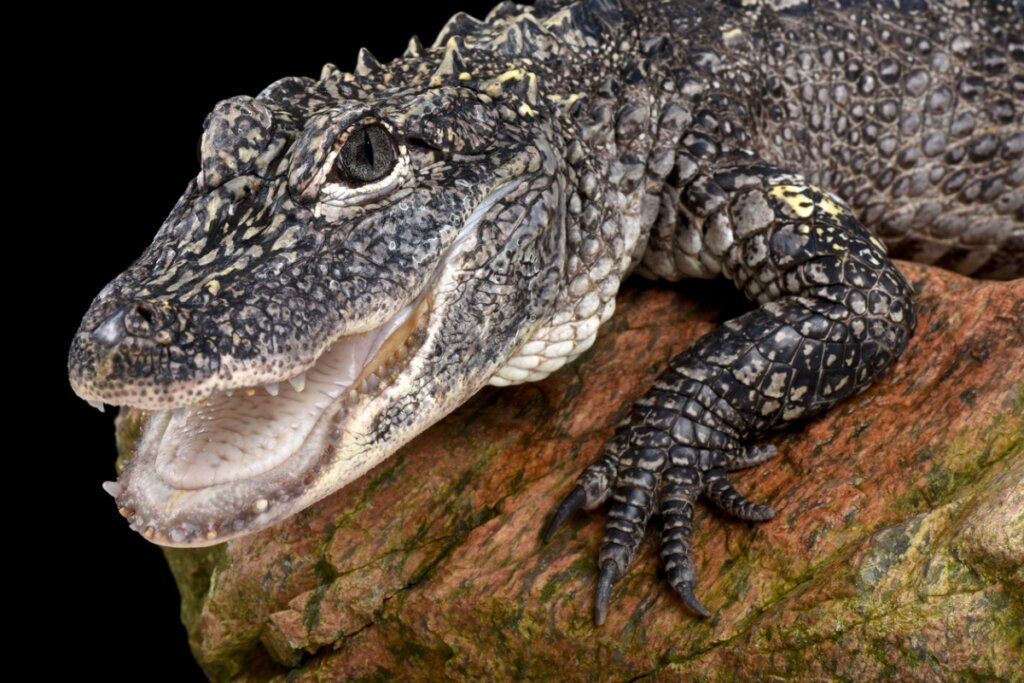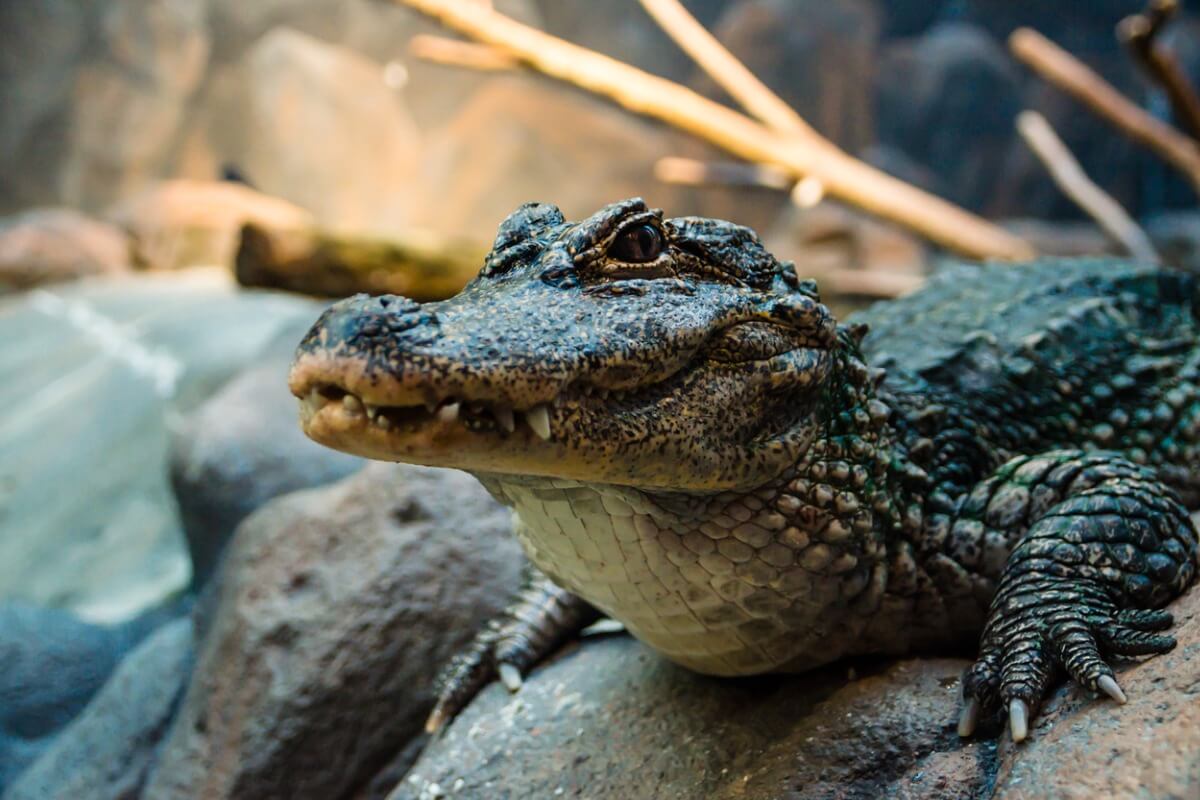Chinese Alligator: Habitat and Characteristics

When we mention crocodiles or alligators, the first thing that comes to mind is a reptile of gigantic proportions. However, the Chinese alligator breaks with this tradition, as they’re so small that they’re almost the size of the dwarf caiman. Even so, it’s still a ferocious animal whose jaws can cause serious damage.
The scientific name for this species is Alligator sinensis and it’s a member of the Alligatoridae family. It isn’t a crocodile in the strict sense of the word, but it is a close relative of these reptiles. Read on to learn more about this small but dangerous animal.
Habitat and distribution of the Chinese alligator
The Chinese alligator is a species of sauropsid endemic to the lower reaches of the Yangtze River in China. Despite this, it’s believed that its population could have been much more abundant in the past and that it encompassed much of the Chinese coastline. This could include regions near the Pacific Ocean (and even Korea). At present, this reptile can only be found in 6 regions of Anhui province.
The preferred habitats of these organisms consist of freshwater areas with subtropical climates. For this reason, places such as swamps, lakes, streams, ponds, and wetlands are important to these reptiles. In addition to this, the great diversity that exists in these places allows them to have a large “menu” available to make up their diet.
What is the Chinese Alligator like?
This alligator somewhat resembles its American relative in that it has a “U” shaped snout, tough skin almost like armor, and a long tail to move in the water. In addition, each of its limbs has strong claws and the teeth fit so well in its jaws that they aren’t obvious to the naked eye.
Even so, one of its greatest characteristics is its size, since its average size is around 1.5 meters long. To compare, the lengths of the dwarf caiman are between 1.2 and 1.6 meters (3.9 to 5.2 feet), while those of the American alligator are greater than 4 meters (just over 13 feet). This classifies it as one of the smallest, at least within its group.
As mentioned above, this reptile has very hardened skin, as it’s covered with osteoderms, which are quite resistant bony scales. This protection covers its entire body and there’s even a plate of bone in the upper part of its eyelids. In addition, at the end of its muzzle, its nose is slightly protruding.
The body of this large predator has dark colors that range from yellow to gray. Likewise, you can also see several black spots on its lower jaw. This pattern is repeated in the same way with the young specimens, except that some yellow bands are added along its body.

Behavior
These reptiles are ectothermic organisms, which is why they depend a lot on the environmental temperature. For this reason, they enter a state of brumation when it’s cold, in which their activity is drastically reduced. This mechanism is similar to hibernation, as it allows them to “sleep” in late autumn and then activate again in spring.
Chinese alligators spend most of their lives in water, so they need to create a refuge in nearby mud banks. This causes them to dig burrows almost a meter (3.3 feet) deep, in which they rest at will.
Generally, when the weather is conducive for them to go out and be active, these alligators spend much of their time basking in the sun to regulate their temperature. Thanks to this, they can activate their metabolism and go hunting at night, which allows them to take advantage of the whole day.
What does the Chinese alligator eat?
This reptile is a carnivore that usually preys on aquatic animals in its environment. Therefore, their diet consists of fish, snails, clams, and amphibians whose capture occurs underwater. However, since its distribution also coincides with human settlements, it sporadically consumes poultry and small mammals.
In addition to this, it’s also common for juveniles to feed on insects.
Reproduction
The breeding season takes place annually during June as it’s a month close to the rainy season. At this time, both sexes begin to vocalize in order to communicate and get a partner. These organisms are polygynous polygamous, so males can fertilize several females, while females only have one mate per year.
Once the couple copulates, the female will be in charge of assembling the nest and chooses a place surrounded by vegetation and mud right next to the body of water. These animals are oviparous, so they need a place to lay their eggs. These animals scoop mud and vegetation with their feet to form mounds almost one meter high in which they’ll place their young.
In general, the mother usually positions her nests near her burrow in order to tend to them during incubation. In fact, the female is the only one who shows parental care with her young, since the males leave as soon as the copulation is finished. What’s more, when the little ones hatch from the egg in September, their mother picks them up at the nest and helps them get into the water.
Conservation status
According to the International Union for Conservation of Nature, this reptile is classified as a critically endangered species. This is because its population has been greatly affected by hunting, the consumption of its meat, and the destruction of its habitat. As of today, its area of distribution is very restricted.
Fortunately, these days, the Chinese alligator is no longer hunted indiscriminately, so it has been able to maintain its number of specimens stable. However, its biggest problem now is the loss of its home, as urbanization and pollution affect this animal a great deal.
Although there are programs that seek their reintroduction, it’s likely that this won’t be enough to prevent their extinction. If the problem that causes the decline of its population isn’t solved, releasing captive-bred individuals will be destining them to death. The challenges to save this reptile are hard to overcome, but hope is the last thing you lose.
All cited sources were thoroughly reviewed by our team to ensure their quality, reliability, currency, and validity. The bibliography of this article was considered reliable and of academic or scientific accuracy.
- Pan, T., Wang, H., Duan, S., Ali, I., Yan, P., Cai, R., … & Wu, X. (2019). Historical population decline and habitat loss in a critically endangered species, the Chinese alligator (Alligator sinensis). Global Ecology and Conservation, 20, e00692.
- Jiang, H. & Wu, X. 2018. Alligator sinensis. The IUCN Red List of Threatened Species 2018: e.T867A3146005. https://dx.doi.org/10.2305/IUCN.UK.2018 1.RLTS.T867A3146005.en.
- Thorbjarnarson, J., Wang, X., & He, L. (2001). Reproductive ecology of the Chinese alligator (Alligator sinensis) and implications for conservation. Journal of Herpetology, 553-558.
- Pan, T., Wang, H., Duan, S., Ali, I., Yan, P., Cai, R., … & Wu, X. (2019). Historical population decline and habitat loss in a critically endangered species, the Chinese alligator (Alligator sinensis). Global Ecology and Conservation, 20, e00692.
- Jiang, H. X., Chu, G. Z., Ruan, X. D., Wu, X. B., Shi, K., Zhu, J., & Wang, Z. (2006). Implementation of China action plan for conservation and reintroduction of Chinese alligator. In Crocodiles. Proceedings of the 18th Working Meeting of the IUCN-SSC Crocodile Specialist Group. IUCN: Gland (pp. 322-332).
